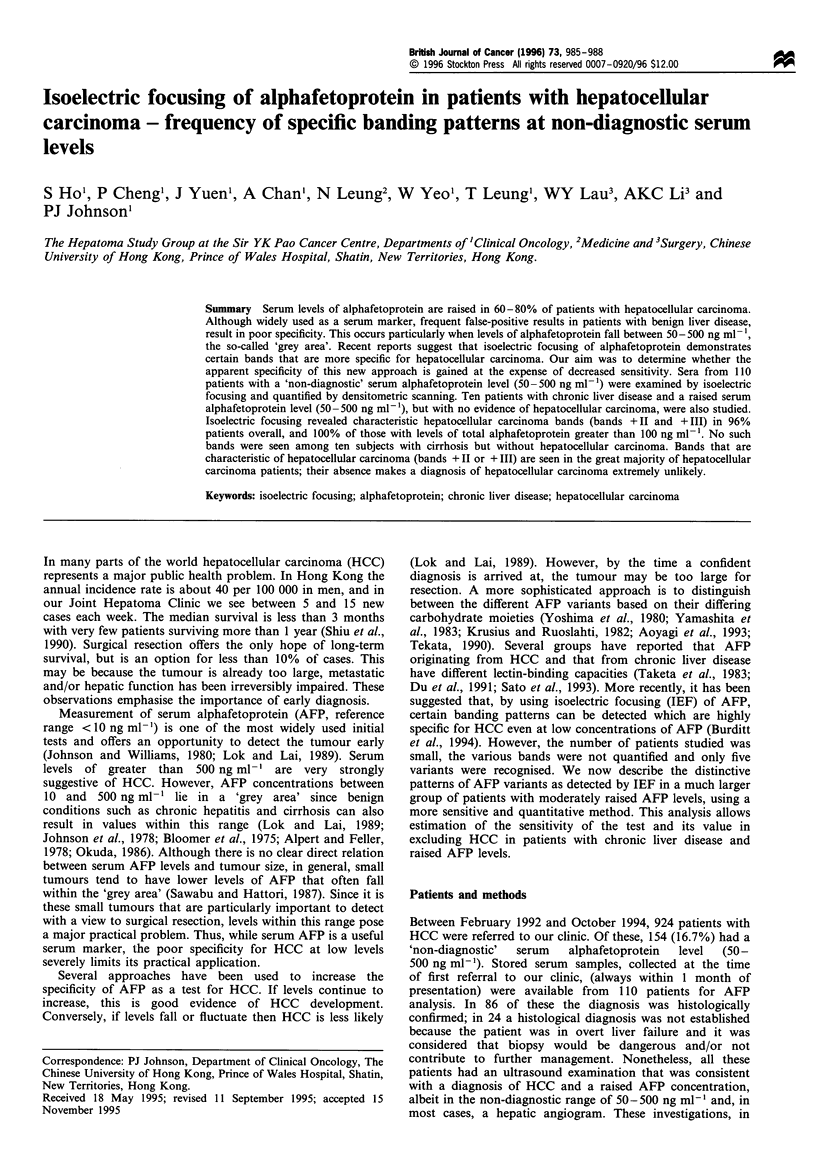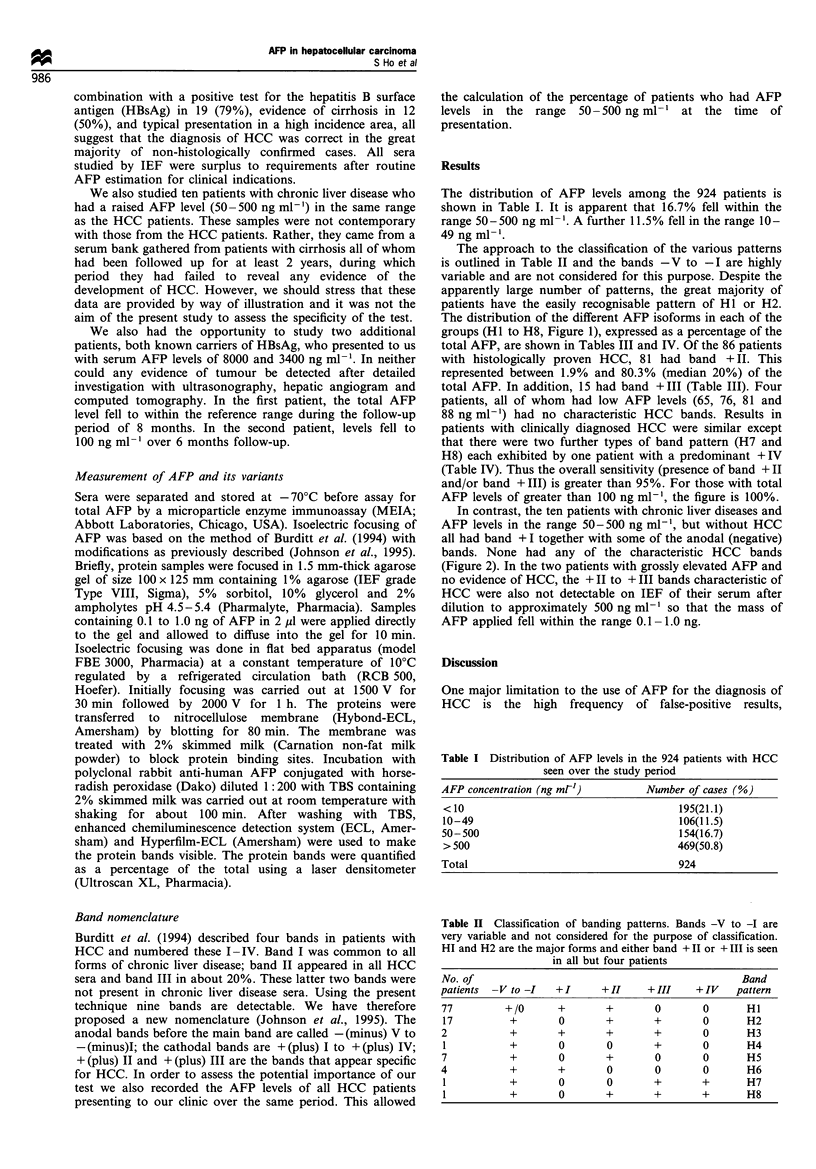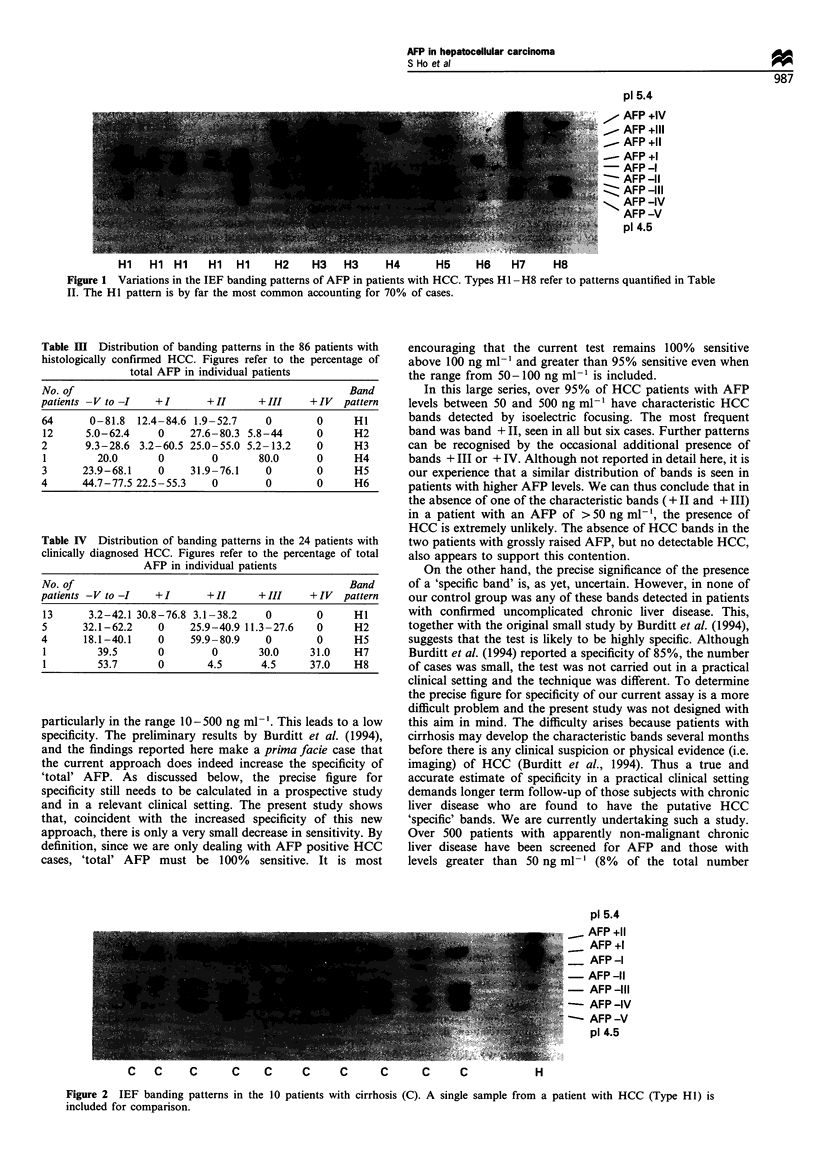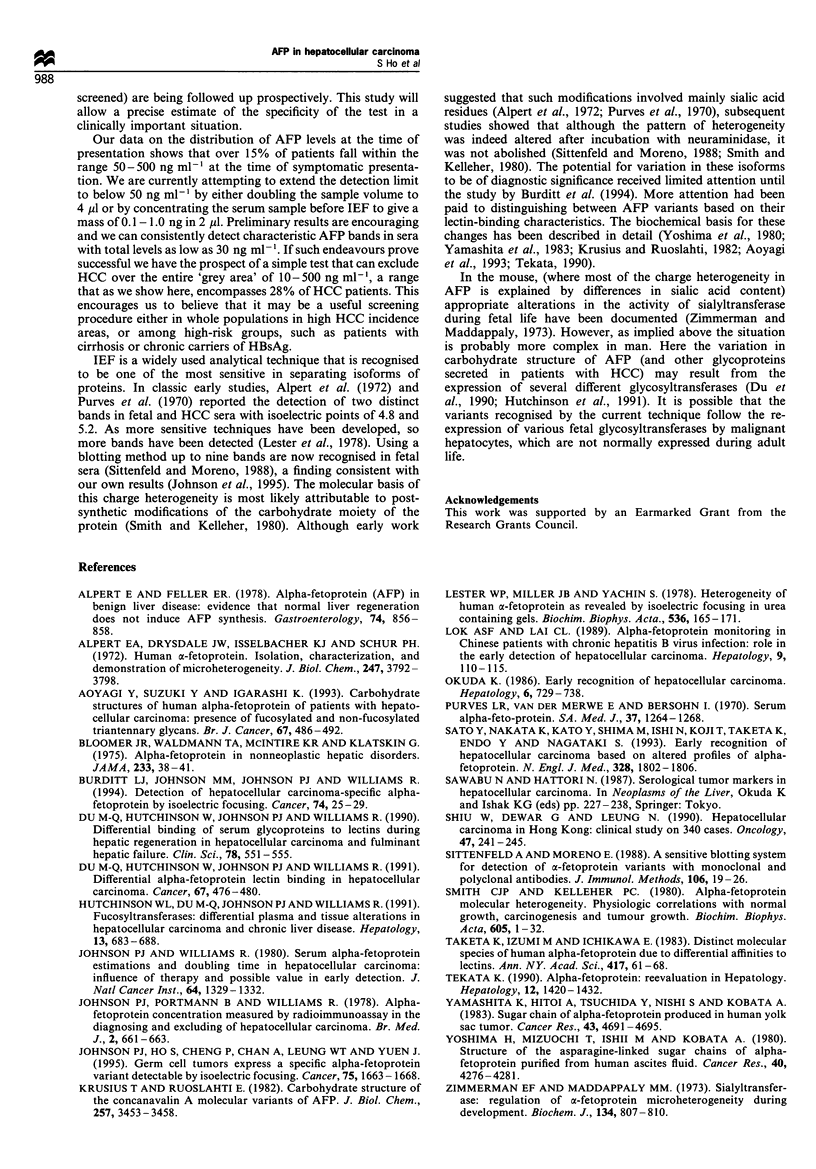Abstract
Serum levels of alphafetoprotein are raised in 60-80% of patients with hepatocellular carcinoma. Although widely used as a serum marker, frequent false-positive results in patients with benign liver disease, result in poor specificity. This occurs particularly when levels of alphafetoprotein fall between 50-500 ng ml-1, the so-called 'grey area'. Recent reports suggest that isoelectric focusing of alphafetoprotein demonstrates certain bands that are more specific for hepatocellular carcinoma. Our aim was to determine whether the apparent specificity of this new approach is gained at the expense of decreased sensitivity. Sera from 110 patients with a 'non-diagnostic' serum alphafetoprotein level (50-500 ng ml-1) were examined by isoelectric focusing and quantified by densitometric scanning. Ten patients with chronic liver disease and a raised serum alphafetoprotein level (50-500 ng ml-1), but with no evidence of hepatocellular carcinoma, were also studied. Isoelectric focusing revealed characteristic hepatocellular carcinoma bands (bands +II and +III) in 96% patients overall, and 100% of those with levels of total alphafetoprotein greater than 100 ng ml-1. No such bands were seen among ten subjects with cirrhosis but without hepatocellular carcinoma. Bands that are characteristic of hepatocellular carcinoma (bands +II or +III) are seen in the great majority of hepatocellular carcinoma patients; their absence makes a diagnosis of hepatocellular carcinoma extremely unlikely.
Full text
PDF



Images in this article
Selected References
These references are in PubMed. This may not be the complete list of references from this article.
- Alpert E., Drysdale J. W., Isselbacher K. J., Schur P. H. Human -fetoprotein. Isolation, characterization, and demonstration of microheterogeneity. J Biol Chem. 1972 Jun 25;247(12):3792–3798. [PubMed] [Google Scholar]
- Alpert E., Feller E. R. Alpha-fetoprotein (AFP) in benign liver disease. Evidence that normal liver regeneration does not induce AFP synthesis. Gastroenterology. 1978 May;74(5 Pt 1):856–858. [PubMed] [Google Scholar]
- Aoyagi Y., Suzuki Y., Igarashi K., Saitoh A., Oguro M., Yokota T., Mori S., Suda T., Isemura M., Asakura H. Carbohydrate structures of human alpha-fetoprotein of patients with hepatocellular carcinoma: presence of fucosylated and non-fucosylated triantennary glycans. Br J Cancer. 1993 Mar;67(3):486–492. doi: 10.1038/bjc.1993.91. [DOI] [PMC free article] [PubMed] [Google Scholar]
- Bloomer J. R., Waldmann T. A., McIntire K. R., Klatskin G. alpha-fetoprotein in noneoplastic hepatic disorders. JAMA. 1975 Jul 7;233(1):38–41. doi: 10.1001/jama.233.1.38. [DOI] [PubMed] [Google Scholar]
- Burditt L. J., Johnson M. M., Johnson P. J., Williams R. Detection of hepatocellular carcinoma-specific alpha-fetoprotein by isoelectric focusing. Cancer. 1994 Jul 1;74(1):25–29. doi: 10.1002/1097-0142(19940701)74:1<25::aid-cncr2820740106>3.0.co;2-u. [DOI] [PubMed] [Google Scholar]
- Du M. Q., Hutchinson W. L., Johnson P. J., Williams R. Differential alpha-fetoprotein lectin binding in hepatocellular carcinoma. Diagnostic utility at low serum levels. Cancer. 1991 Jan 15;67(2):476–480. doi: 10.1002/1097-0142(19910115)67:2<476::aid-cncr2820670226>3.0.co;2-8. [DOI] [PubMed] [Google Scholar]
- Du M. Q., Hutchinson W. L., Johnson P. J., Williams R. Differential binding of serum glycoproteins to lectins during hepatic regeneration in hepatocellular carcinoma and fulminant hepatic failure. Clin Sci (Lond) 1990 Jun;78(6):551–555. doi: 10.1042/cs0780551. [DOI] [PubMed] [Google Scholar]
- Hutchinson W. L., Du M. Q., Johnson P. J., Williams R. Fucosyltransferases: differential plasma and tissue alterations in hepatocellular carcinoma and cirrhosis. Hepatology. 1991 Apr;13(4):683–688. [PubMed] [Google Scholar]
- Johnson P. J., Ho S., Cheng P., Chan A., Leung T., Yuen J. Germ cell tumors express a specific alpha-fetoprotein variant detectable by isoelectric focusing. Cancer. 1995 Apr 1;75(7):1663–1668. doi: 10.1002/1097-0142(19950401)75:7<1663::aid-cncr2820750717>3.0.co;2-o. [DOI] [PubMed] [Google Scholar]
- Johnson P. J., Portmann B., Williams R. Alpha-fetoprotein concentrations measured by radioimmunoassay in diagnosing and excluding hepatocellular carcinoma. Br Med J. 1978 Sep 2;2(6138):661–663. doi: 10.1136/bmj.2.6138.661. [DOI] [PMC free article] [PubMed] [Google Scholar]
- Johnson P. J., Williams R. Serum alpha-fetoprotein estimations and doubling time in hepatocellular carcinoma: influence of therapy and possible value in early detection. J Natl Cancer Inst. 1980 Jun;64(6):1329–1332. doi: 10.1093/jnci/64.6.1329. [DOI] [PubMed] [Google Scholar]
- Krusius T., Ruoslahti E. Carbohydrate structure of the concanavalin A molecular variants of alpha-fetoprotein. J Biol Chem. 1982 Apr 10;257(7):3453–3457. [PubMed] [Google Scholar]
- Lester E. P., Miller J. B., Yachnin S. Heterogeneity of human alpha-fetoprotein as revealed by isoelectric focusing in urea-containing gels. Biochim Biophys Acta. 1978 Sep 26;536(1):165–171. doi: 10.1016/0005-2795(78)90062-4. [DOI] [PubMed] [Google Scholar]
- Lok A. S., Lai C. L. alpha-Fetoprotein monitoring in Chinese patients with chronic hepatitis B virus infection: role in the early detection of hepatocellular carcinoma. Hepatology. 1989 Jan;9(1):110–115. doi: 10.1002/hep.1840090119. [DOI] [PubMed] [Google Scholar]
- Okuda K. Early recognition of hepatocellular carcinoma. Hepatology. 1986 Jul-Aug;6(4):729–738. doi: 10.1002/hep.1840060432. [DOI] [PubMed] [Google Scholar]
- Sato Y., Nakata K., Kato Y., Shima M., Ishii N., Koji T., Taketa K., Endo Y., Nagataki S. Early recognition of hepatocellular carcinoma based on altered profiles of alpha-fetoprotein. N Engl J Med. 1993 Jun 24;328(25):1802–1806. doi: 10.1056/NEJM199306243282502. [DOI] [PubMed] [Google Scholar]
- Shiu W., Dewar G., Leung N., Leung W. T., Chan M., Tao M., Lui C., Chan C. L., Lau W. Y., Metreweli C. Hepatocellular carcinoma in Hong Kong: clinical study on 340 cases. Oncology. 1990;47(3):241–245. doi: 10.1159/000226823. [DOI] [PubMed] [Google Scholar]
- Sittenfeld A., Moreno E. A sensitive blotting system for detection of alpha-fetoprotein variants with monoclonal and polyclonal antibodies. J Immunol Methods. 1988 Jan 21;106(1):19–26. doi: 10.1016/0022-1759(88)90266-9. [DOI] [PubMed] [Google Scholar]
- Smith C. J., Kelleher P. C. Alpha-fetoprotein molecular heterogeneity. Physiologic correlations with normal growth, carcinogenesis and tumor growth. Biochim Biophys Acta. 1980 Mar 12;605(1):1–32. doi: 10.1016/0304-419x(80)90020-7. [DOI] [PubMed] [Google Scholar]
- Taketa K., Izumi M., Ichikawa E. Distinct molecular species of human alpha-fetoprotein due to differential affinities to lectins. Ann N Y Acad Sci. 1983;417:61–68. doi: 10.1111/j.1749-6632.1983.tb32849.x. [DOI] [PubMed] [Google Scholar]
- Yamashita K., Hitoi A., Tsuchida Y., Nishi S., Kobata A. Sugar chain of alpha-fetoprotein produced in human yolk sac tumor. Cancer Res. 1983 Oct;43(10):4691–4695. [PubMed] [Google Scholar]
- Yoshima H., Mizuochi T., Ishii M., Kobata A. Structure of the asparagine-linked sugar chains of alpha-fetoprotein purified from human ascites fluid. Cancer Res. 1980 Nov;40(11):4276–4281. [PubMed] [Google Scholar]
- Zimmerman E. F., Madappally M. M. Sialyltransferase: regulation of alpha-foetoprotein microheterogeneity during development. Biochem J. 1973 Jul;134(3):807–810. doi: 10.1042/bj1340807. [DOI] [PMC free article] [PubMed] [Google Scholar]




